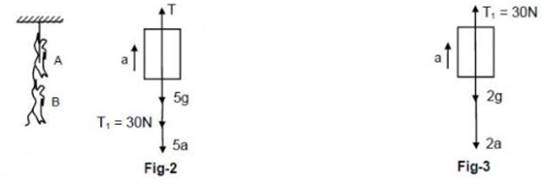The monkey B shown in figure (5-E20) is holding on to the tail of the monkey A which is climbing up a rope. The masses of the monkeys A and B are 5 kg and 2 kg respectively. If A can tolerate a tension of 30 N in its tail, what force should it apply on the rope in order to carry the monkey B with it? Take g = 10 m/s2.


Given: Let the acceleration of monkey A upwards be a, so that a maximum tension of 30 N is produced in its tail.
T − 5g − 30 − 5a = 0 …(i)
30 − 2g − 2a = 0 …(ii)
From equations (i) and (ii), we have: T = 105 N (max.) and a = 5 m/s2
So, A can apply a maximum force of 105 N on the rope to carry monkey B with it.
For minimum force, there is no acceleration of A and B.
T1 = weight of monkey B ⇒ T1 = 20 N
Rewriting equation (i) for monkey A, we get: T − 5g − 20 = 0 ⇒ T = 70 N
∴ To carry monkey B with it, monkey A should apply a force of magnitude between 70 N and 105 N